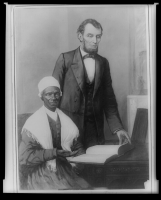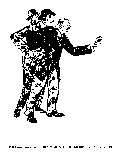|
In a hurry? Save or print these Collection Connections as a single file.
Go directly to the collection, Votes for Women: Selections from the National American Woman Suffrage Association Collection, 1848-1921, in American Memory, or view a Summary of Resources related to the collection.
This online collection contains 167 items from the larger National American Woman
Suffrage Association Collection. The selected items include many important texts
from the beginning of the movement for women's right to vote through 1920, when the
Nineteenth Amendment was passed. The collection shows a wide variety of opinions and
strategies that helped win voting rights for women.

Mrs. Carrie Chapman Catt. (In 1920, after the 36th state had ratified.) |
1) Woman Suffrage
In 1938, Carrie Chapman Catt,
a key coordinator in the woman suffrage movement, donated her collection of woman
suffrage materials to the Library of Congress. Her collection chronicles the movement
to gain the vote for women. Most of the materials are from speeches and meetings of
activists, both women and men, who argued for and against woman suffrage.
Search on the names of
well-known people who campaigned for women's right to vote including Susan
B. Anthony, Henry Blackwell, Carrie Chapman Catt, Lucretia Mott and Lucy Stone.
For example, search on
Lucy Stone for text such as, |
Gentlemen will see it is no new claim that women are making. They
only ask for the practical application of
admitted, self-evident truths. If "all political power is inherent in the people,"
why have women, who are
more than half the entire population of this State, no political existence? Is
it because they are not people?... Women are even held to be citizens without
the full rights of citizenship, but
to bear the burden of "taxation without representation," which is "tyranny."
From "
Woman
Suffrage in New Jersey. An address by Lucy Stone at a hearing before the New Jersey
Legislature, March 6, 1867."
![Daguerreotype portrait of a woman working at a
sewing machine.[c 1853]](images/sew.gif)
Occupational
portrait of a woman working at a sewing machine. [c 1853]
From
America's First Look
at the Camera: Daguerreotypes, 1842-1862. |
2) Other Legal Rights
It took many years of organized struggle for women to gain the right to vote.
However, between the first woman suffrage convention in 1848, and the ratification
of the Nineteenth Amendment in 1920, women and others did gain voting rights in
some states. During this time, women also lobbied for child labor laws, women's
labor rights, and education.
Search on child labor,
laws, and women's trade unions. For example, in
"The
Trade Union Woman," [1915] Alice Henry gives an overview of the women's trade union
movement. In "Persuasion or Responsibility," Florence Kelley reports on child labor
and illiteracy. She says, |
According to the latest report of the Department of Education, the per cent of our population enrolled in
the public schools had diminished during the past five years. The cotton fields of the South call for the black
children, the cotton mills, wherever found, summon the white children. In the middle states, the
sweat-shops of the great cities, the glassworks, and the Pennsylvania mines absorb the boys and girls.
Schools cost money, and boards of education are composed chiefly of business men, men eager to keep
down the taxes and willing to have children work. ...
It may be a mere coincidence,(but an interesting one), that illiteracy looms largest where women have least
power, and grows less where they vote. Of the twenty states which have fewest illiterate children, women
vote in eighteen.
From
"Persuasion
or Responsibility," by Florence Kelley, Political Equality Series, Vol II. No. 8,
Published Monthly by the National American Woman Suffrage Association. [c 1900]

A.
Lincoln showing Sojourner Truth the Bible presented by colored people of Baltimore,
Executive Mansion, Washington, D.C., Oct. 29, 1864.
From Portraits of
the Presidents and First Ladies, 1789-Present. |
3) Abolitionist Movement
The woman suffrage movement rose in part from other reform movements, including
the movement to end slavery. Documents in the collection, such as
"Proceedings
of the Anti-Slavery Convention of American Women . . ." [1838], highlight the
relationship between the rights of women and the rights of slaves and former slaves.
Search on abolition
and slavery for documents that emphasize connections between abolitionism and
the women's rights movement. Search
on Sojourner Truth for some of the speeches of this famous former slave. For
example, at the American Equal Rights Association meeting in 1867, Sojourner Truth
said, |
The object of this Association is to "secure Equal Rights to
all American citizens, especially the Right of Suffrage, irrespective of race, color
or sex." American Democracy has interpreted the Declaration of Independence in the
interest of slavery, restricting suffrage and citizenship to a white male
minority. The black man is still denied the crowning right of
citizenship, even in the nominally free States .... Half our population are
disfranchised on the ground of sex; and though compelled to obey the law and
taxed to support the government, they have no voice in the legislation of the
country. This Association, then, has a mission to perform, the magnitude and
importance of which cannot be over-estimated.
From "Proceedings
of the First Anniversary of the American Equal Rights Association, held at the
Church of the Puritans, New York, May 9 and 10, 1867."

"For some odd reason the Wholesale Liquor Dealers Association doesn't happen
to like the idea of female suffrage."
From,
"How
it feels to be the husband of a suffragette, by him.
Illustrations by May Wilson Preston. [c. 1915] |
4) Other Reforms: Temperance, Marriage, Religion
Among the reform movements of this period, documents discussing temperance,
marriage, and religion can be found in this collection.
Search on
religion for such documents as
"Woman's
Right to Preach the Gospel" [1853], which is the sermon preached at the ordination
of the first American woman into the clergy.
Search on temperance
for such documents as
"Address
Before the Second Biennial Convention of the World's Christian Temperance Union" [1893],
by Frances Elizabeth Willard, which relates temperance to other areas of reform.
Search on husband,
marriage, and wife for documents about women's rights in a marriage.
"For
RentóOne Pedestal," [1917], contains a lively set of letters by Marjorie Schuler
narrating her account of being, at first, a reluctant activist in the suffrage movement.
The humorous "How It Feels to Be the Husband of a Suffragette" includes this
commentary: | Lots of good men who have no
intellectual objection to women's voting nurse at heart a timidity whenever
they visualize the horrible results. You can see it in many a polite, genteel
citizen's eye, the moment suffrage talk starts, as if he were wondering just
what his own women folks would act like around the house if they knew they were
as good as he was and could prove it legally.
Of course it is a false alarm. The percentage of divorces doesn't rise in
suffrage states because of suffrage; and logically there is no more reason why
two domestic partners who are comrades,
mutually acknowledging a pleasant equality, should separate, than there is for
the separation of two people of opposite sex
who, condemned to live together, are striving diligently to maintain an inequality.
From "How
it Feels to be the Husband of a Suffragette, by him." [c1915]

The
Western College for Women Class of 1904, Oxford, Ohio.
From
Touring Turn-of-the-Century America, 1880-1921.
|
5) Education
Significant advances in education for
women took place during the period covered by this collection. As with other reforms,
there was a struggle to gain advances in women's educational opportunities.
Search on education
for documents about improving women's access to education. For example, the
group of essays, "Women and the Alphabet" discusses women's education and employment
opportunities. The first essay describes the differences between pay for male and
female teachers: |
But every female common-school teacher in the United States finds
the enjoyment of her four hundred dollars a year to be secretly embittered by the
knowledge that the young college stripling in the next schoolroom is paid twice
that sum for work no harder or more responsible than her own, and that, too, after
the whole pathway of education has been obstructed for her, and smoothed for him.
From, "Women
and the Alphabet; a Series of Essays," by Thomas Wentworth Higginson. 1900.
|



